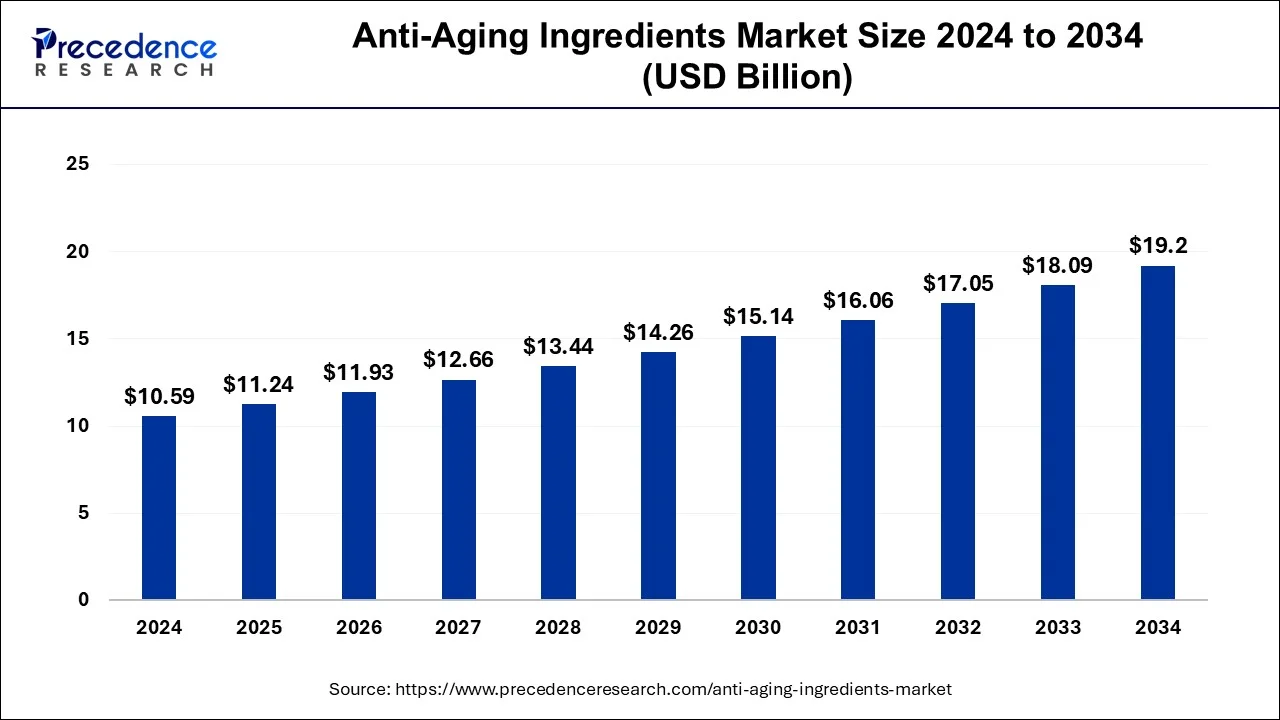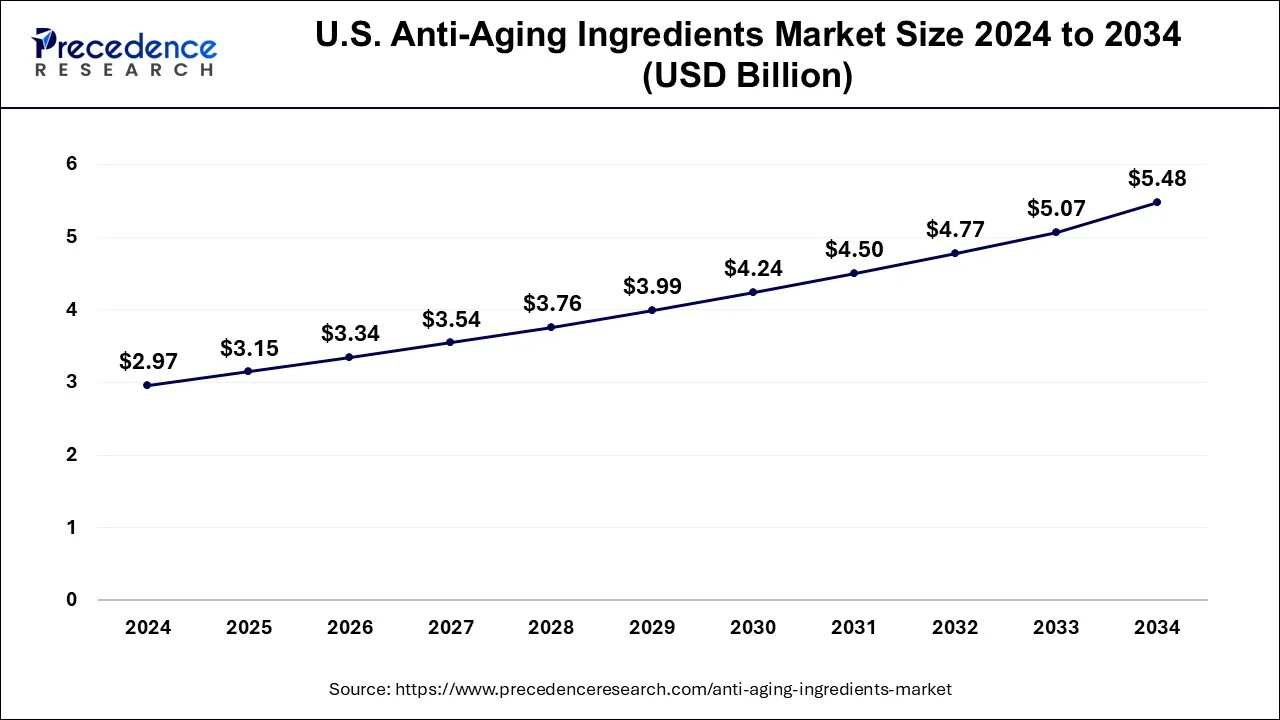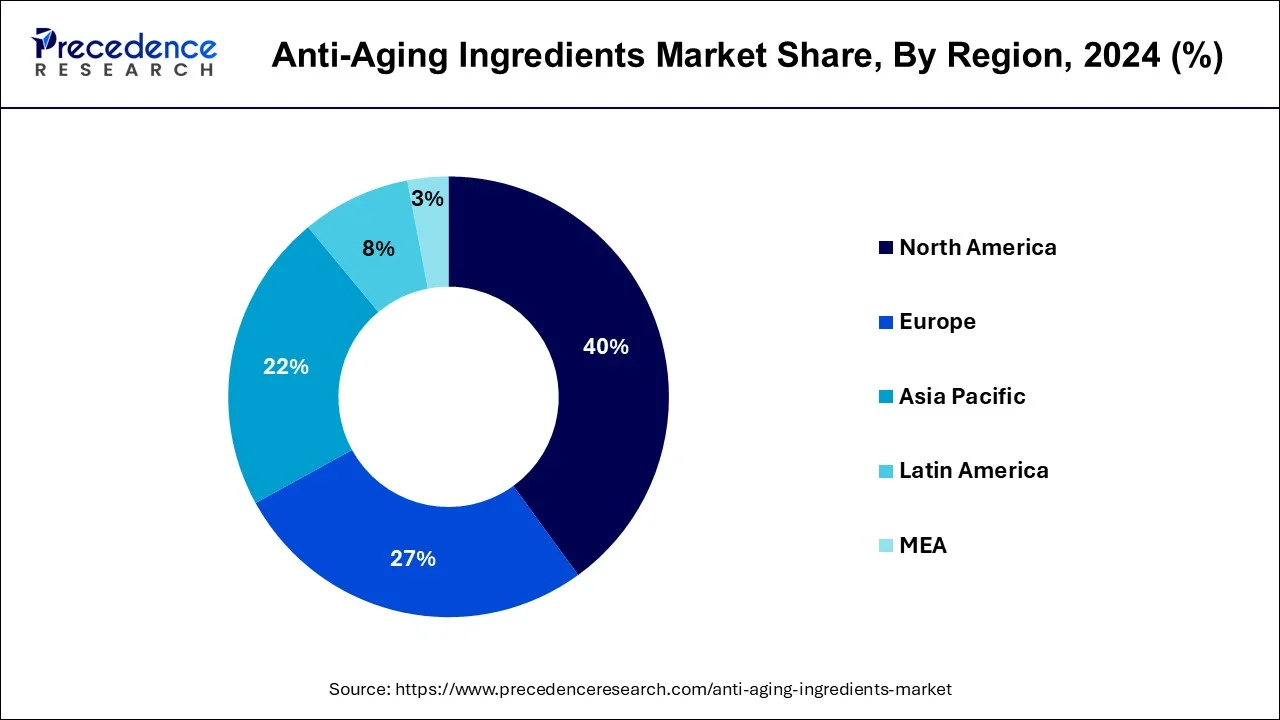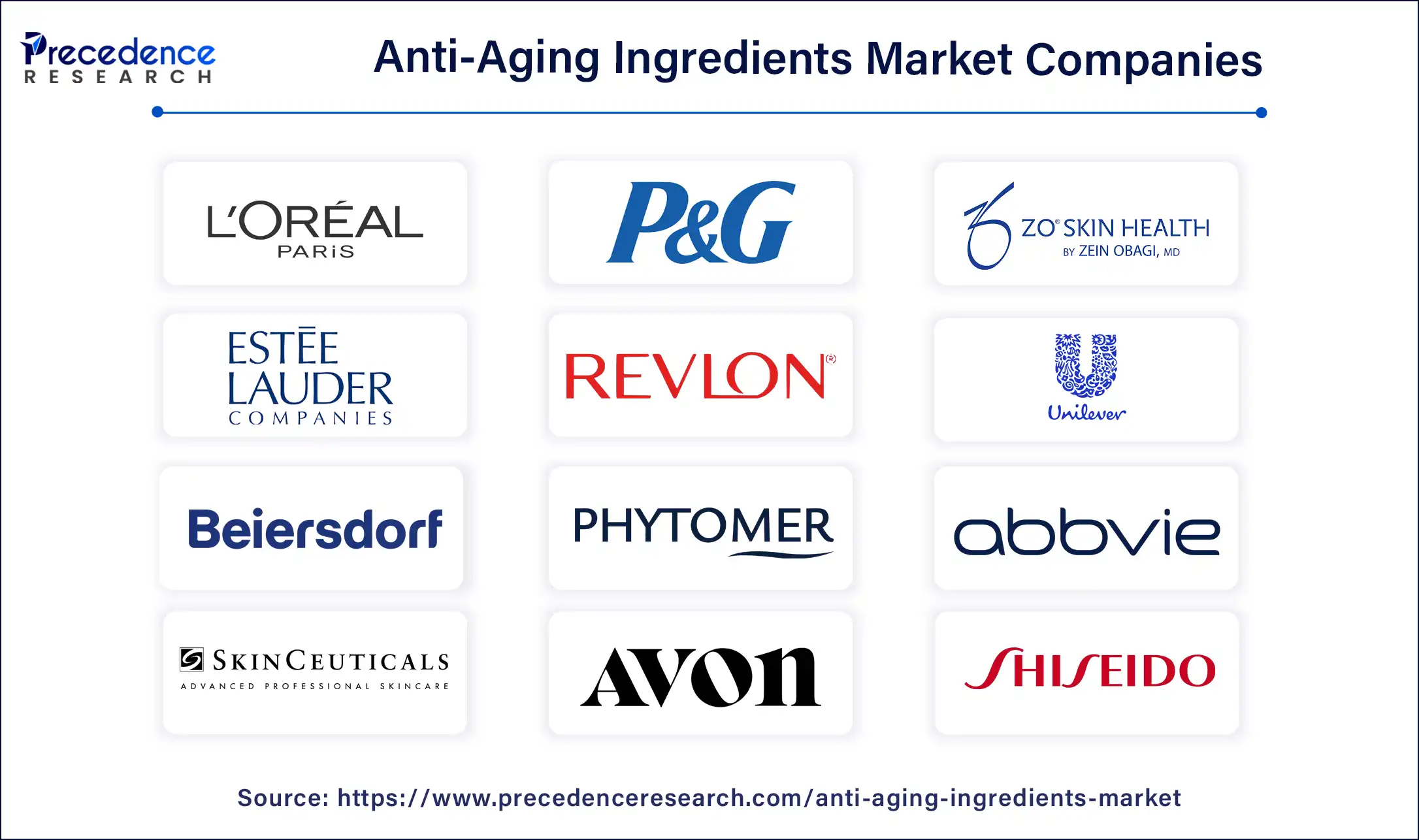January 2025
The global anti-aging ingredients market size is calculated at USD 11.24 billion in 2025 and is forecasted to reach around USD 19.2 billion by 2034, accelerating at a CAGR of 6.13% from 2025 to 2034. The North America market size surpassed USD 4.24 billion in 2024 and is expanding at a notable CAGR of 6.26% during the forecast period. The market sizing and forecasts are revenue-based (USD Million/Billion), with 2024 as the base year.
The global anti-aging ingredients market size accounted for USD 10.59 billion in 2024 and is expected to exceed USD 19.2 billion by 2034, growing at a CAGR of 6.13% from 2025 to 2034. The rising demand for the anti-aging ingredients market is experienced due to the increasing conscious awareness of protecting one's own skin from external stress and encouraging renewed skin.

Integration of artificial intelligence technology is expected to revolutionize the beauty and cosmetics industry. Artificial intelligence in the anti-aging ingredients market utilizes datasets at the molecular, genetic, and biophysical information levels to gain a deeper understanding and help strengthen skin resilience. AI also plays a crucial role in the appearance and stimulation of skin, along with hair and nails. AI-driven technology contributes to skin aging research through method development and data acquisition, interpretation, and evaluation. Additionally, it supports drug development, optimizes treatment, and aids in proving the effectiveness of personalized approaches.
The U.S. anti-aging ingredients market size was evaluated at USD 2.97 billion in 2024 and is projected to be worth around USD 5.48 billion by 2034, growing at a CAGR of 6.32% from 2025 to 2034.

North America dominated the global anti-aging ingredients market in 2024. The dominance of the region is noticed due to the rising awareness regarding anti-aging and its benefits. There has been a high adoption of skincare products, particularly anti-aging products, as the population is experiencing signs of aging due to increasing pollution, stress, and unhealthy lifestyles. In the States, skincare is a treatment approach; when the skin is already damaged, people start opting for anti-aging products to treat it. Apart from the United States, Canada also has the biggest skincare and cosmetic industry. Additionally, the American population has adopted skin-tightening and cellulite-reducing treatments and products significantly.

Asia Pacific is anticipated to witness the fastest growth in the anti-aging ingredients market during the forecasted years. The growth of the region is observed due to Japan and South Korea having the largest skincare revenue per capita. The rapidly growing population in countries such as Japan, South Korea, China, and Singapore is encouraging growth. Asian skin care products are cost-effective as they feature sleek and minimalist packaging, unlike Western beauty brands. The priority is on the quality of the product and not the packaging. Korean skincare is more towards a preventative approach.
Anti-aging ingredients are chemically formulated products that help get rid of issues that come with older age, including fine lines, wrinkles, less elasticity, and uneven tone. Aging is a natural process; however, incorporating some skincare products into daily skincare routine with specific active ingredients can help reduce these effects and maintain youthful skin. Chemical peels and exfoliants are two commonly used techniques to eliminate aging signs and improve skin conditions. For an immediate result, dermatologists recommend undergoing medical treatments such as prescription creams, injections, chemical peels, microneedling, and laser treatments. Skin protection from direct sun exposure also prevents early signs of aging to an extent by including sunscreen in a daily skincare regime.
| Report Coverage | Details |
| Market Size by 2024 | USD 10.59 Billion |
| Market Size in 2025 | USD 11.24 Billion |
| Market Size in 2034 | USD 19.2 Billion |
| Market Growth Rate from 2025 to 2034 | CAGR of 6.13% |
| Leading Region | North America |
| Fastest Growing Region | Asia Pacific |
| Base Year | 2024 |
| Forecast Period | 2025 to 2034 |
| Segments Covered | Ingredient Type, Product Category, Target Group, Application, and Regions |
| Regions Covered | North America, Europe, Asia-Pacific, Latin America, and Middle East & Africa |
Increasing adoption of cosmetics and skin care
People are becoming more conscious and learning the importance of skincare. People understand how anti-aging products can help to prevent wrinkles, age spots, and other signs of aging. Along with that, it enhances the overall complexion and makes them look best. Lifestyle changes contribute to the growth of skincare. Poor diet and prolonged exposure to skin damage the skin, breaking its protective barrier, which increases the adoption of the anti-aging ingredients market to create a positive impact on the skin.
High cost
There is a high cost associated with the production of active ingredients in anti-aging products, which keeps the price elevated. Some main ingredients are priced at tens of thousands of RMB per kilogram, leading to the end products bearing hefty price tags. The high cost is driven by research expenses, and the development of new products and formulation requires a great investment. Luxury brands in the anti-aging ingredients market produce small batches of products to maintain quality and increase the cost. Furthermore, greater marketing campaigns and retailer markups contribute to the expensiveness of the product.
Getting rid of the glycation process
The research and development department at Beiersdoft has ultimately revealed the secret behind achieving longtime and perfect anti-aged skin. Various scientific studies show that excessive sugar consumption has negative impacts on the skin and causes wrinkles. For the last ten years, the company has been working on discovering the importance of Q10 in skin aging. Co-enzyme Q10 in skin care is an essential active ingredient in the anti-aging field. NIVEA was the first brand to launch Q10 products more than 25 years ago. However, the innovation of NAHP- N-Acetyl-L-hydroxyproline helps in preventing the glycation reaction from occurring and prevents the formation of advanced glycation end product (AGEs) at a 68% rate by weakening the sugar molecules before they can bind with proteins and weaken collagen fibers. The combination of GLYCOSTOP and anti-wrinkle active ingredient Q10 is a cutting-edge blend to prevent skin from aging.
The antioxidants segment dominated the global anti-aging ingredients market in 2024. The dominance of this segment is noticed as antioxidants neutralize the free radicals and protect the skin from damage. Free radicals cause oxidative stress and accelerate the aging process. Common antioxidant ingredients are vitamin C, retinol and niacinamides. Antioxidants help fight against the visible signs of aging and calm the skin. It brings a youthful appearance and revitalizes dull-looking skin, which can be caused by airborne pollutants and blue light exposure.
The peptide segment will witness significant growth in the anti-aging ingredients market during the forecast period. The growth of this segment is mainly observed as peptides are amino acids that are essential fragments of proteins such as collagen and elastin. This specifically targets the key factors in aging and makes the skin loot form and more resilient. According to the survey, 25 to 30 years of age is the ideal age for starting to use peptides. Growth hormone stimulants such as CJC 1295 and Ipamorelin are two of the most used anti-aging peptides.
The serums and essences segment contributed the largest share of the anti-aging ingredients market in 2024. The dominance of this segment is credited to its nourishing properties, which have become an essential part of the daily skin care regimen for millions of people globally. The serum and essences are originally from the K-beauty industry. The product acts as a primer for the moisturizer, offering a lot of extra benefits to the skin. Commonly found active ingredients are retinol, peptides, and vitamin C, which boost collagen production and encourage cell growth.
The moisturizer and lotions segment is expected to grow at the fastest CAGR in the anti-aging ingredients market during the forecast period. The growth of this segment is observed as moisturizer temporarily adds some fullness to the skin, helping to reduce fine lines and wrinkles. The presence of active ingredients such as vitamin C, retinol, ceramides, and various exfoliating skin care acids is found according to the skin type and concerns.
The women segment captured the biggest share of the anti-aging ingredients market in 2024. A survey states that 75% of women recognized fine lines and wrinkles as early signs of aging, and only 42% are using targeted anti-aging solutions. This data determines the lack of awareness among consumers about the right aging regime and the value-added products to address aging signs. Additionally, 85% of women wanted to start attending to these skin aging issues sooner.
The men's segment is projected to grow at a significant CAGR in the anti-aging ingredients market during the forecast period. Anti-aging products for men include a basic list of items such as moisturizers, serums, and eye creams. The products are formulated for men’s thicker skin and lightweight properties, which absorb into the skin, minimizing the appearance of wrinkles and lines.
The facial care segment captured the biggest share of the anti-aging ingredients market in 2024. The aging signs are predominantly visible on the face after their 30s. Most people start to notice the changes in their faces around the ages of 40 and 50. Fine lines appear first, and wrinkles, a loss of volume, and a loss of elasticity become noticeable over time. Applying UV protection of at least SPF 30 or higher and wearing protective clothes can prevent aging on the face.
The skin care segment is expected to grow at the fastest CAGR in the market during the forecast period. The expansion of this segment is observed as people are becoming more aware of the importance of taking care of the entire body of skin and not just facial skin. Using widely available vitamin C, niacinamide, retinol, and peptide-incorporated skincare products for entire body skin, including body wash, lotion, masks, scrubs, and many more. They have shown incredible results, fading dark spots, loose skin, and uneven texture.

By Ingredient Type
By Product Category
By Target Group
By Application
By Geography
For inquiries regarding discounts, bulk purchases, or customization requests, please contact us at sales@precedenceresearch.com
No cookie-cutter, only authentic analysis – take the 1st step to become a Precedence Research client
January 2025
August 2023
January 2024
January 2025